

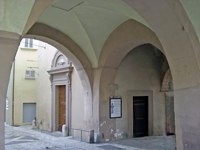
This original church here, which was also known as San Giovanni de Platea, belonged to the Commune and was probably built soon after the sack of Trevi in 1214.
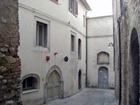
The Commune jealously guarded its rights over the church:
-
✴In 1372, the Commune resisted an attempt by Pope Gregory XI to give it to the Augustinians, forbidding the friars to set foot in the town and forbidding the citizens to sell them any property.
-
✴In 1375, the Commune prevented an episcopal visit by the Bishop of Spoleto to the church and adjacent hospice.
-
✴In 1501, the Commune united it with its other church, the Madonna delle Lacrime, which was administered by a community of Lateran Canons.
-
✴In 1570, the Commune ceded the church to the Compagnia della Misericordia, which took over an adjacent house in 1626 and adapted it as an oratory.
-
✴In ca. 1600, the Commune resisted an attempt by Cardinal Erminio Valenti to give the complex to the Barnabites.
The hospital remained in use until the Napoleonic period, when it was transferred to the suppressed convent of San Domenico (since demolished). Its building was used for a period as a prison.
The façade and the interior of the church were remodelled the in the neo-Classical style in the 19th century, perhaps inspired by Giuseppe Valadier's stay in Trevi in 1832.
Interior
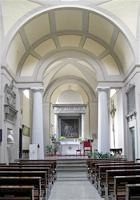
The high altar is covered by a baldachino, with the Valenti arms at the base on the left. The church also has two side altars:
-
✴The altar on the left belonged to the Università dei Muratori (bricklayers' guild). The inscription (1612) at the base marks the burial of members, described as "Lombardi , muratori e scalpellini" (artisans from Lombardy, bricklayers and stone masons). The wooden Crucifix (late 16th century), in which the figure of Christ has movable arms, was used in Passion plays.
-
✴The altar on the right, which was decorated in stucco in 1682 by the Abbati family, has a wooden statue (early 17th century) of the Risen Christ.
Altarpiece (early 17th century)
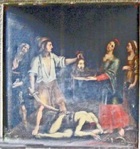
Monument to Alessandro Valenti (ca. 1570)
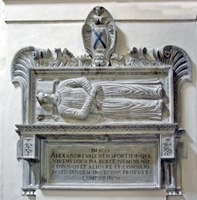
This monument, which has a depiction of the deceased in high relief and a funerary inscription, is on the left wall. A longer inscription on the right wall outlines his career, including the facts that:
-
✴he was the rector of the Compagnia della Misericordia (to whom he made a major bequest in his will); and
-
✴Pope Julius III gave him the Villa di Rivosecco. (This carried with it the title of Conti di Rivosecco, an honour that Pope Pius V confirmed and made hereditary in 1566).
Art from the Hospice
Cornice of a Processional Standard (ca. 1478)
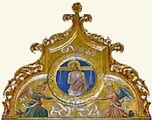
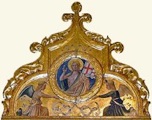
This double-sided cornice was documented in 1872 in the hospital in the ex-convent of San Domenico and is now in the Pinacoteca. Each side has an image of Christ in a tondo with two angles below: the Crucified Christ is on one side and the Risen Christ is on the other. The cornice probably belonged to a processional banner, and the fact that the Crucified Christ is depicted with two whips makes it likely that it had belonged to a penitential confraternity. The cornice is attributed to Pierantonio Mezzastris, and may well have been commissioned after the outbreak of plague in Trevi in 1478.
Sources in the 18th century document a gilded cornice with an image of the Crucified Christ above a panel of the Assumption of the Virgin on the altar of the now-demolished church of Santa Maria della Piaggia, which belonged to the penitential Confraternita di Santa Maria della Piaggia. This was probably the side of cornice illustrated above, to the left. If this link is correct, it is possible to reconstruct the history of the cornice before 1872. The likelihood is that, when Santa Maria della Piaggia was abandoned, the possessions of the confraternity passed to the Compagnia della Misericordia, who administered the hospice at San Giovanni Decollato. These goods would have been moved again to the new hospital at San Domenico in 1817. At some point in this tortuous history, the main panel of the Assumption of the Virgin (which was probably also double-sided) must have been lost.

